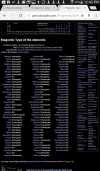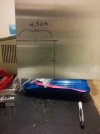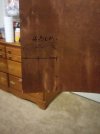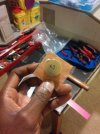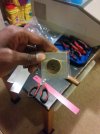You are using an out of date browser. It may not display this or other websites correctly.
You should upgrade or use an alternative browser.
You should upgrade or use an alternative browser.
Free energy and HAARP technology
- Thread starter Inquorate
- Start date
Inquorate said:QER: _http://youtu.be/--xufBweiFU link not valid please see next post
The video does not show clearly the measurements, not even what is measured. Also, there is no sensible description. Schematics?
Inquorate said:I should note that all I've done here is replicate the inventor's work, after doing research. Please don't share the video link to everyone.
Note that this forum is public.
Inquorate
Jedi Master
I have already posted a 'schematic', it produces energy; about 1 joule per second, which is admittedly not much but it can be scaled up. With a couple of neo magnets, copper and aluminum foil and polystyrene, plastic, etc, a couple of 1n4148 high frequency diodes an a small capacitor, anyone can see it for themselves. Just dont leave the meter leads on, they drain the ccapacitor quicker than a single stack can charge it.
You would need terrawats of background RF to fill a capacitor to 6 or even 2volts, so no its not that.
You would need terrawats of background RF to fill a capacitor to 6 or even 2volts, so no its not that.
N
no-mans-land
Guest
Inquorate said:I have already posted a 'schematic', it produces energy; about 1 joule per second, which is admittedly not much but it can be scaled up. With a couple of neo magnets, copper and aluminum foil and polystyrene, plastic, etc, a couple of 1n4148 high frequency diodes an a small capacitor, anyone can see it for themselves. Just dont leave the meter leads on, they drain the ccapacitor quicker than a single stack can charge it.
You would need terrawats of background RF to fill a capacitor to 6 or even 2volts, so no its not that.
Inquorate said:To be honest, this is not the forum for technical discussions. If youre interested, try it. If not, thats ok too.
I guess you are pretty sure that what you are doing is valid and I also belief that behind your work there is knowledge about what you are doing. So, this should be no dismissal of your work and no attempt to go into technical discussions or whatsoever.
When I saw your video, like Data said:
The video does not show clearly the measurements, not even what is measured. Also, there is no sensible description. Schematics?
And that's the general problem that was pointed out several times and the reason why such things just go unnoticed (for good reasons). From the video, there is nothing to see what could be used to verify whatever there may be that can be verified.
You build that thing, and to build it, you must have had some sort of idea. If this thing can produce electricity, then why make it so complicated to prove something? I mean, why not put an low voltage LED on it and let it shine. This device seems to be so small that you can hold it between your fingers without any cable attached. Then create a technical drawing that is so easy to understand that everyone who is interested will become capable to recreate that thing and verify that it really works.
From that point on, technical discussions do make sense. If you want to transmit some kind of knowledge, you also have the responsibility to make the effort to put that knowledge into a shape so that it can be received and understood by others. Really, I would be one of the first ones who would try to verify it but till now, there is just no usable piece of information to do it.
Inquorate
Jedi Master
The peeps were interested in seeing it going. Ive got a lot going on atm, And I promise you all when I can light an led, I will. 1 joule per second wont light an led. I did the video initially for a couple of cco-replicators, and didnt need to show them what they could see for themselves.
next time I'll use the good camera, tripod etc.
feel free to watch the four videos Dr Stiffler uploaded, just search for Dr Stiffler quantum energy receiver. He shows measurements,
next time I'll use the good camera, tripod etc.
feel free to watch the four videos Dr Stiffler uploaded, just search for Dr Stiffler quantum energy receiver. He shows measurements,
cubbex
The Living Force
Buddy said:Prometeo said:Why would there be any offence? if you are a "scientist" you got to be prepared to the criticism.
I meant that I wasn't intending to offend you with my comments. I might have been overstepping my bounds, though, so my apologies if so. I'll probably be working on my impulse control forever.
No problems bud I know you on the forum for a long time, I know you are a good guy. :)
I want to add another comment. Working on the self is important to achieve this understanding level. The universe provides the keys to know these things to those who have the wisdom to use it properly.
curious_richard
Jedi Master
I have tested a number of LEDs, and most ordinary ones will give good light at 10 milliamps at 1.8 to 2.0 volts. One joule/second (1 watt) could power 50 LEDs if the voltage is just right.Inquorate said:And I promise you all when I can light an led, I will. 1 joule per second wont light an led.
Inquorate
Jedi Master
curious_richard said:I have tested a number of LEDs, and most ordinary ones will give good light at 10 milliamps at 1.8 to 2.0 volts. One joule/second (1 watt) could power 50 LEDs if the voltage is just right.Inquorate said:And I promise you all when I can light an led, I will. 1 joule per second wont light an led.
Good point. I believe that the distance between plates is important. I could be wrong, but I really need to do a lot more experiments to understand it fully, and increase the output. Baby steps, and early days.
Inquorate
Jedi Master
I should expand on that comment. The previous incarnation of Dr Stiffler's work was the Spatial Energy Coherer or SEC. It relied on both the spatial resonance and self resonance of coils to build on a natural (or any other) frequency. I did two videos at the time on how to find the SRF and srf of a coil. Each coil had to be made to exact dimensions in order to build on the resonance of the one proceding. Change a component of the device, or even move a component on the circuit board, and you change the space, hence throw out theresonance. It was insanely difficult.
…Finding the spatial resonance of a coil
https://www.youtube.com/watch?v=eQhOtm-TLAg
…Finding Self Resonant Frequency of an inductor
https://www.youtube.com/watch?v=90PQmDOaTAk
So, in one of the new, Quantum Energy Receiver videos posted by Dr Stiffler, he mentions he uses a divider between plates that is 1/100th of an inch thick. At that thickness, using the same quantum translational speed required to work out the spatial resonance of the coils, but using the earth's magnetic frequency resonance, (if I did the math correcty - admittedly not my strong point) then we are looking at a situation where having the appropriate width of diamagnetic and paramagnetic layers will increase the output. I have ordered a high precision vernier caliper in order to make those measurements.
So, I think I just got lucky so far. More work to do.
…Finding the spatial resonance of a coil
https://www.youtube.com/watch?v=eQhOtm-TLAg
…Finding Self Resonant Frequency of an inductor
https://www.youtube.com/watch?v=90PQmDOaTAk
So, in one of the new, Quantum Energy Receiver videos posted by Dr Stiffler, he mentions he uses a divider between plates that is 1/100th of an inch thick. At that thickness, using the same quantum translational speed required to work out the spatial resonance of the coils, but using the earth's magnetic frequency resonance, (if I did the math correcty - admittedly not my strong point) then we are looking at a situation where having the appropriate width of diamagnetic and paramagnetic layers will increase the output. I have ordered a high precision vernier caliper in order to make those measurements.
So, I think I just got lucky so far. More work to do.
curious_richard
Jedi Master
I know I am just jumping into this, but do the plates have to be separated by air? If an insulator is okay between copper plates, it might be convenient to use circuit board material, which comes in many thicknesses. Here is one example:Inquorate said:So, in one of the new, Quantum Energy Receiver videos posted by Dr Stiffler, he mentions he uses a divider between plates that is 1/100th of an inch thick.
_http://www.goldmine-elec-products.com/prodinfo.asp?number=G18750
(I am not sure if I should de-activate the link, so I did it to be safe.)
Inquorate
Jedi Master
so long as you use both paramagnetic and diamagnetic materials, you do something to the spinning magnetic field lines, which makes the quantum waves spit out particles in different amounts on each plate. That's the basic theory. I haven't seen the numbers, equations but Ive been assure that theyre quite simple.
curious_richard
Jedi Master
I will have to stop now and think some more. I wonder if electroplating the "right" mixture of iron, cobalt, nickel, and/or rare earths onto copper would work.Inquorate said:so long as you use both paramagnetic and diamagnetic materials, you do something to the spinning magnetic field lines, which makes the quantum waves spit out particles in different amounts on each plate.
Thanks for giving me something interesting to think about.
trendsetter37
The Living Force
monotonic said:I still don't know what is between those two plates.
It looks and sounds like cellophane. If so you could harvest that from the wrappers that are on individual cigarette boxes.
Inquorate, I think I am going to follow along to what happens. I only have 1N4764A diodes at the moment so I have some 1N4148s in the mail.
I got the magnets from _http://kjmagnetics.com a looong you may not be able to find them anymore but they are so strong they are dangerous.

